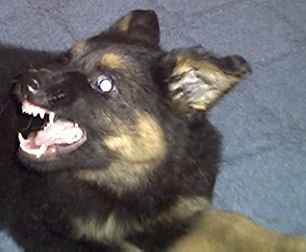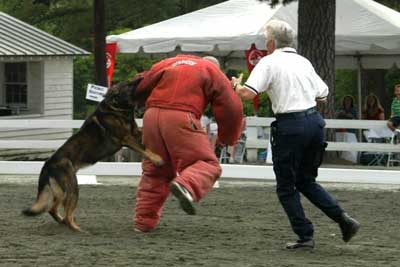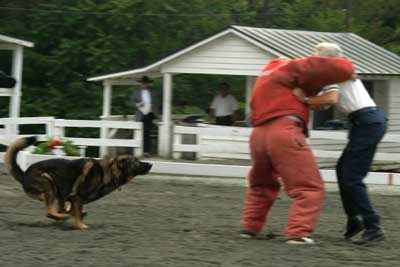K-9 Certificate Standards
Tracking Standards
1) 1 - 3 mile unknown track ( 15,840 feet = 4,800 meters ) includes
3 water crossings
2) 1 - 1.5 mile unknown track ( 7,920 feet = 2,400 meters ) includes
hard surface tracking
3) Each track consists of multiple turns and multi surfaces and will be
at least 20 minutes old and no older than 2 hours old.
4) No obtuse angles will be used. The tracks will be laid as a normal person would walk/run.
5) No article or "scent pad" is used at the start (a general area only will
be given - 50 foot square)
6) The suspect/victim will remain passive at the end of the track
7) There maybe up to 4 articles of evidence placed on the tracks,
but they will not be placed within the first 10 meters or within the last
50 meters of the tracks. Each piece of evidence will be well scented with
the scent of the tracklayer.
8) Each article of evidence will be consistent with evidence realistically
found and will not be less than 8cm and no larger than 25 cm. Example, handgun, glove, keys, etc.
9) The handler will be required to pass a written exam, passing score 85% which consists of proper handling techniques, proficiency training techniques,
K-9 behavior, scent work and theories, etc.
Narcotics Detection
1) The 10 narcotic odors trained on will be used (4 used of each) ranging
from 1 gram to 158 grams (total number of plants 40)
2) Each team shall be required to detect and locate 95% of each odor in
the following areas;
A) Vehicles Interior Exterior
B) Buildings
a) House trailer
b) Warehouse or Storage area
c) Lockers
C) Luggage
a) 6 pieces of luggage as a minimum will be searched
D) Open Areas
a) Hides will be placed under the surfaces up to 4 feet high
3) The handler will be required to pass a written exam, passing score 85% which consists of court case studies, proper handling techniques, proficiency training techniques, K-9 behavior, scent work and theories, etc.
Cadaver Detection
1) 20 cadaver aides will be used
2) Each team shall be required to detect and locate 95% of the odor in the following areas;
A) Vehicles Interior
B) Buildings
a) House trailer
b) Warehouse or Storage area
C) Open Areas
a) Hides will be placed under the surfaces and up to 8 feet high
3) The handler will be required to pass a written exam, passing score 85% which consists of court case studies, proper handling techniques, K-9 behavior, proficiency training techniques, scent work and theories, etc.
Criminal Apprehension / Patrol
1) Obedience shall be tested on and off leash and consist of the following
with distractions;
a) Sit
b) Down
c) Stay
d) Come (re-call)
e) Heel
2) Each will be conducted 3 X minimum
3) Off leash work will be conducted with no leash or collar
4) Agility / Obstacle Work will consist of the following;
a) Four (4) foot wall
b) Window jump
c) Open Stairs (ascending and descending)
d) Barrel Climb (consist of 6 plastic 55 gallon barrels)
e) Five and one half (5 ½) foot wall with dismounting ramp
f) Chain Link Fence jump
g) Seven (7) foot incline wall (90 degrees or less than but
greater than 50)
h) Teeter Totter
i) Five (5) foot ladder connected to a catwalk eight (8) feet in length with a dismount ramp. The catwalk will be approximately five (5) foot above ground.
5) Apprehension Phase (Body Suit, Hard Sleeves, and Hidden Sleeves
will be used)
6) Each test will be conducted off leash with no leash or collar
7) Each test will start with the dog in the down stay position beside the handler
a) Apprehend a threatening and charging suspect with a 1 meter X 3cm stick. At the signal of the evaluator the dog will be commanded to release the suspect. At which time the handler may leave the dog guarding the suspect or recall the dog to the heel position. At the signal of the evaluator the handler will heel his dog away.
b) Apprehend a fleeing suspect after he fires 2 gunshots, one of which shall be before the dog is within 10 feet of the suspect but after the dog has crossed the half way point. The dog will aggressively pursue and apprehend the suspect. At the signal of the evaluator the dog will be commanded to release the suspect. At which time the handler may leave the dog guarding the suspect or recall the dog to the heel position. At the signal of the evaluator the handler will heel his dog away.
c) Pat down the dog shall remain in the down stay position as the handler pats down a passive suspect and then moves behind the suspect 10 to 20 feet and calls the dog past the suspect into the heel position.
d) Pat down with attack on handler. This will be conducted as the Pat Down with passive suspect except at anytime during the pat down the suspect will suddenly and violently attach the handler. The dog shall attach the suspect at that time without any commands to do so by the handler. The dog will be given the command to release the suspect and either guard him intensely of shall be recalled to the hell position. The pat down will then continue with the suspect remaining passive. The dog will then be called to the heel position and a transport will begin.
e) Recall the dog will aggressively pursue fleeing suspect. At the signal of the evaluator the handler will by verbal command only have the dog end the pursuit and either have the dog go into a down stay position or recall the dog to the heel position. At the signal of the evaluator the handler either have the handler heel the dog away, or transport the suspect.
f) Transport the dog will be required to non aggressively but intensely transport the suspect at it's handler's command. The dog may conduct the transport directly behind the suspect or to one side or the other. At the desecration, of the evaluator the handler shall have to dog either transport the suspect from a distance no less than one (1) foot or greater than two (2) meters. The handler will have the dog transport the suspect for a minimum distance of 25 paces with one (1) left turn and one (1) right turn. The transport will end when the handler commands the suspect to Halt and heels the dog away.
8) Building Search will consist of two (2) of the following: house trailer a warehouse or office complex.
a) Each building search will begin with the handler taking a tactical position outside of the building.
b) At the desecration of the evaluator, the suspect(s) will be either located out of reach of the dog or within reach of the dog but will be hidden from immediate view of the dog. The suspect(s) will be hidden from view five (5) minutes prior to the test
c) At the signal of the evaluator, the handler will commence the test by giving the loud verbal announcements. After which the handler will release the dog to search for and locate the suspect.
d) The handler will tactically move though the building to a position to control the dog. The handler will do so in accordance
to the situation.
e) The test will be completed when the handler transports the suspect from the area or upon a signal from the evaluator.
9) Area Search will consist of a wooded area 50 meters square.
a) The suspect will be hidden from view five (5) minutes prior
to the test.
b) At the signal of the evaluator the handler will commence the test by giving the loud verbal announcements. After which the handler will release the dog to search for and locate the suspect.
c) The dog will search the area by utilizing its sense of smell or hearing to locate the suspect.
d) The dog will locate the suspect who at the desecration of the evaluator, will either remain passive or become combative at the presence of the dog. The dog will respond according to the suspect's actions. By either guarding a passive suspect or apprehending a combative suspect.
e) The test will be completed when the handler transports the suspect from the area or upon a signal from the evaluator.
f) The handler will tactically move though the area to a position
to control the dog. The handler will do so in accordance to the situation.
10) The handler will be required to pass a written exam, passing score 85% which consists of case law studies, proper handling techniques, proficiency training techniques, K-9 behavior, scent work and theories, etc. |



 email if you want to advertise here
email if you want to advertise here